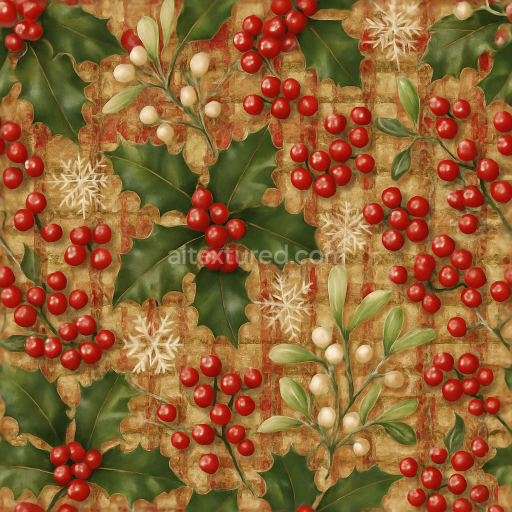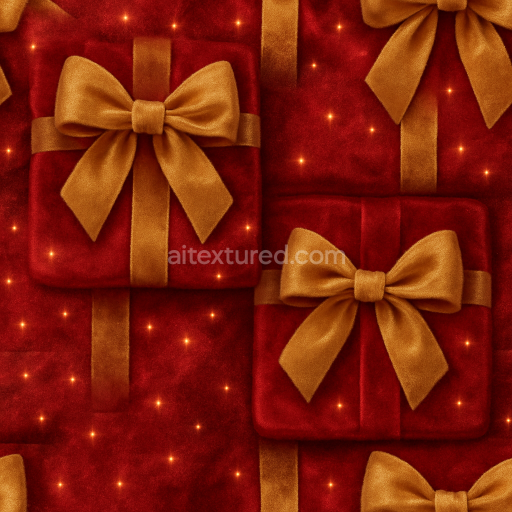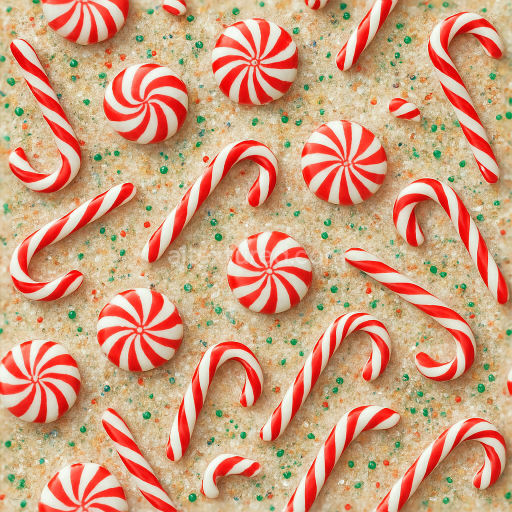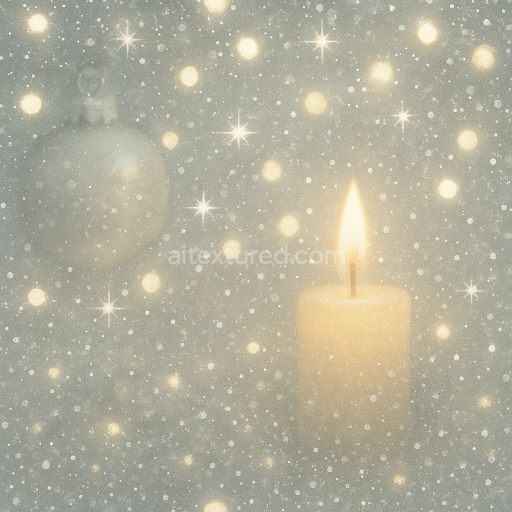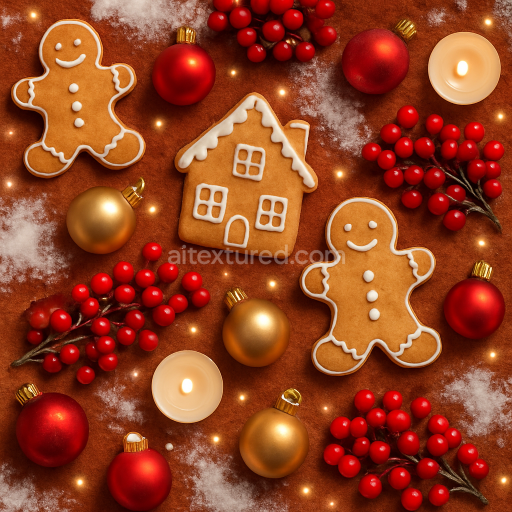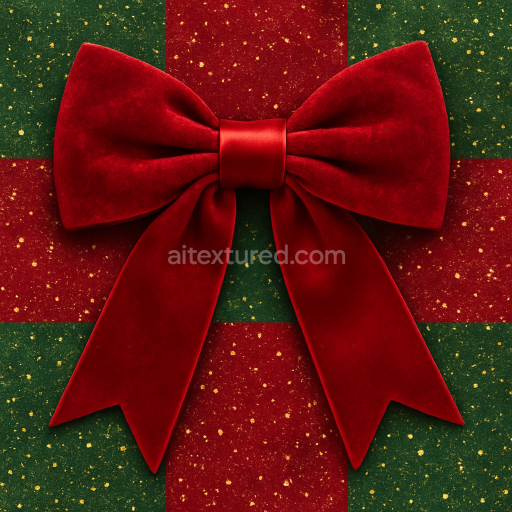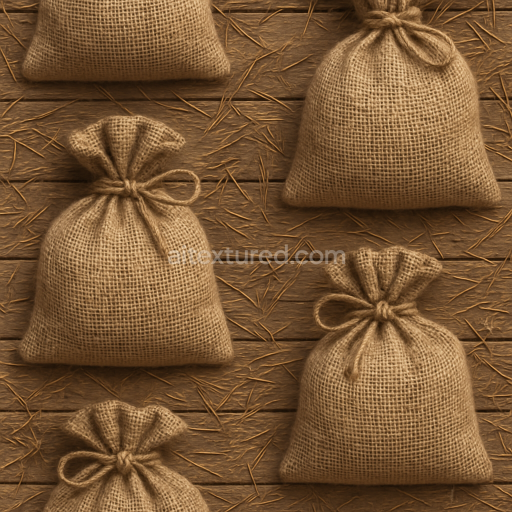This seamless 3D texture presents a richly detailed composition of holly leaves holly berries mistletoe and bright red berries designed with an intricate organic pattern that mimics natural foliage clusters. The underlying base material is reminiscent of finely grained botanical surfaces combining a slightly veined leaf structure with smooth rounded berry forms. The substrate appears as a delicate fibrous matrix akin to real plant tissue where microscopic veins create subtle height variations and natural roughness. The holly leaves exhibit a semi-glossy waxy finish capturing the characteristic sheen of evergreen foliage while the berries possess a polished almost translucent surface that reflects light softly. Interspersed elements such as festive plaid fabric gold glitter accents candle wax drips and scattered snowflakes add a layered complexity suggesting a composite surface where textile fibers metallic flakes and soft wax materials blend into the organic forms creating a multidimensional tactile experience.
From a materials science perspective the texture’s composition can be described as a multi-layered assembly where a fibrous cellulose-like substrate supports pigment-rich binders and adhesive compounds that hold glitter and wax aggregates in place. The color palette draws heavily on natural green and red pigments derived from chlorophyll and anthocyanins analogs enhanced by synthetic metallic gold flakes and soft white crystalline deposits resembling snow. The porosity is minimal on the berry surfaces providing a smooth dense appearance while the leaves maintain a slightly porous matte-to-semi-gloss finish with subtle microtexture to convey realism. Weathering effects are delicately simulated through minor surface imperfections and gentle edge wear contributing to an authentic tactile feel without compromising the seamless continuity. The overall surface finish balances between polished highlights on the berries and a brushed natural texture on the foliage delivering a compelling contrast that enhances visual depth.
Technically this texture is crafted with physically based rendering (PBR) workflows in mind optimized for 8K resolution to capture extreme detail and fine structural nuances. The BaseColor (Albedo) channel accurately represents the vibrant greens deep reds and metallic golds without baked lighting ensuring versatility under varied environmental lighting conditions. Normal maps encode the fine vein structures and berry contours creating realistic light interaction and surface relief. Roughness maps define the differential glossiness between waxy leaves and glossy berries while the Metallic channel highlights the gold glitter flakes subtly embedded within the composition. Ambient Occlusion maps add depth by simulating soft shadows in crevices between leaves and berries. Height or displacement maps provide additional geometric detail enabling parallax or tessellation effects to enhance the three-dimensional feel in rendering engines.
Designed to integrate seamlessly with Blender Unreal Engine and Unity this texture supports high-fidelity visualization workflows and real-time applications alike. For optimal results it is advisable to adjust the UV scale carefully to maintain natural proportions of leaves and berries on large surfaces preventing distortion or repetition artifacts. Additionally fine-tuning the roughness values can help achieve desired reflectivity under different lighting setups while blending height maps with normal maps can enhance the perception of depth without excessive geometry. This texture’s versatility makes it suitable for holiday-themed digital environments product visualizations and decorative assets requiring authentic photorealistic Christmas foliage.
How to Use These Seamless PBR Textures in Blender
This guide shows how to connect a full PBR texture set to Principled BSDF in Blender (Cycles or Eevee). Works with any of our seamless textures free download, including PBR PNG materials for Blender / Unreal / Unity.
What’s inside the download
*_albedo.png — Base Color (sRGB)*_normal.png — Normal map (Non-Color)*_roughness.png — Roughness (Non-Color)*_metallic.png — Metallic (Non-Color)*_ao.png — Ambient Occlusion (Non-Color)*_height.png — Height / Displacement (Non-Color)*_ORM.png — Packed map (R=AO, G=Roughness, B=Metallic, Non-Color)

Quick start (Node Wrangler, 30 seconds)
- Enable the addon: Edit → Preferences → Add-ons → Node Wrangler.
- Create a material and select the Principled BSDF node.
- Press Ctrl + Shift + T and select the maps
albedo, normal, roughness, metallic (skip height and ORM for now) → Open.
The addon wires Base Color, Normal (with a Normal Map node), Roughness, and Metallic automatically.
- Add AO and Height using the “Manual wiring” steps below (5 and 6).
Manual wiring (full control)
- Create a material (Material Properties → New) and open the Shader Editor.
- Add an Image Texture node for each map. Set Color Space:
- Albedo → sRGB
- AO, Roughness, Metallic, Normal, Height, ORM → Non-Color
- Connect to Principled BSDF:
albedo → Base Colorroughness → Roughnessmetallic → Metallic (for wood this often stays near 0)normal → Normal Map node (Type: Tangent Space) → Normal of Principled.
If details look “inverted”, enable Invert Y on the Normal Map node.
- Ambient Occlusion (AO):
- Add a MixRGB (or Mix Color) node in mode Multiply.
- Input A =
albedo, Input B = ao, Factor = 1.0.
- Output of Mix → Base Color of Principled (replaces the direct albedo connection).
- Height / Displacement:
Cycles — true displacement
- Material Properties → Settings → Displacement: Displacement and Bump.
- Add a Displacement node: connect
height → Height, set Midlevel = 0.5, Scale = 0.02–0.08 (tune to taste).
- Output of Displacement → Material Output → Displacement.
- Add geometry density (e.g., Subdivision Surface) so displacement has polygons to work with.
Eevee (or lightweight Cycles) — bump only
- Add a Bump node:
height → Height.
- Set Strength = 0.2–0.5, Distance = 0.05–0.1, and connect Normal output to Principled’s Normal.
Using the packed ORM texture (optional)
Instead of separate AO/Roughness/Metallic maps you can use the single *_ORM.png:
- Add one Image Texture (Non-Color) → Separate RGB (or Separate Color).
- R (red) → AO (use it in the Multiply node with albedo as above).
- G (green) → Roughness of Principled.
- B (blue) → Metallic of Principled.
UVs & seamless tiling
- These textures are seamless. If your mesh has no UVs, go to UV Editing → Smart UV Project.
- For scale/repeat, add Texture Coordinate (UV) → Mapping and plug it into all texture nodes.
Increase Mapping → Scale (e.g., 2/2/2) to tile more densely.
Recommended starter values
- Normal Map Strength: 0.5–1.0
- Bump Strength: ~0.3
- Displacement Scale (Cycles): ~0.03
Common pitfalls
- Wrong Color Space (normals/roughness/etc. must be Non-Color).
- “Inverted” details → enable Invert Y on the Normal Map node.
- Over-strong relief → lower Displacement Scale or Bump Strength.
Example: Download Wood Textures and instantly apply parquet or rustic planks inside Blender for architectural visualization.
To add the downloaded texture, go to Add — Texture — Image Texture.

Add a node and click the Open button.

Select the required texture on your hard drive and connect Color to Base Color.





